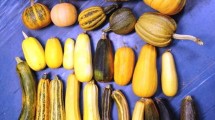Abstract
Two molecular markers, a RAPD (randomly amplified polymorphic DNA) and a RFLP/STS (restriction fragment length polymorphism/sequence-tagged site), previously were found associated with apomictic reproductive behavior in a backcross population produced to transfer apomixis from Pennisetum squamulatum to pearl millet. The occurrence of these molecular markers in a range of 29 accessions of Pennisetum comprising 11 apomictic and 8 sexual species was investigated. Both markers were specific for apomictic species in Pennisetum. The RFLP/STS marker, UGT 197, was found to be associated with all taxa that displayed apomictic reproductive behavior except those in section Brevivalvula. Neither UGT197 nor the cloned RAPD fragment OPC-04600 hybridized with any sexually reproducing representatives of the genus. The cloned C04600 was associated with 3 of the 11 apomictic species, P. ciliare, P. massaicum, and P. squamulatum. UGT197 was more consistently associated with apomictic reproductive behavior than OPC04600 or cloned C04600, thus it could be inferred that UGT197 is more closely linked to the gene(s) for apomixis than the cloned C04600. The successful use of these probes to survey other Pennisetum species indicates that apomixis is a trait that can be followed across species by using molecular means. This technique of surveying species within a genus will be useful in determining the relative importance of newly isolated markers and may facilitate the identification of the apomixis gene(s).
Similar content being viewed by others
References
Brown WV, Emery WHP (1958) Apomixis in the Gramineae: Panicoideae. Am J Bot 45:253–263
Brunken J, De Wet JMJ, Harlan JR (1977) The morphology and domestication of pearl millet. Econ Bot 31:163–174
Chatterji AK, Timothy DH (1969a) Microsporogenesis and embryogenesis in Pennisetum flaccidum Griseb. Crop Sci 9:219–222
Chatterji AK, Timothy DH (1969b) Apomixis and tetraploidy in Pennisetum orientale Rich. Crop Sci 9:796–799
Chowdhury MKU, Smith RL (1988) Mitochondrial DNA variation in pearl millet and related species. Theor Appl Genet 76:25–32
Clegg MT, Rawson JRY, Thomas K (1984) Chloroplast DNA variation in pearl millet and related species. Genetics 106:449–461
D'Cruz R, Reddy PS (1968) Apomixis in Pennisetum massaicum Stapf. Sci Cult 34:255–257
Devos KM, Atkinson MD, Chinoy CN, Francis HA, Harcourt RL, Koebner RMD, Liu CJ, Masojc P, Gale MD (1993) Chromosomal rearragements in the rye genome relative to wheat. Theor Appl Genet 85:673–680
Durjardin M, Hanna W (1984) Microsporogenesis, reproductive behavior, and fertility in five Pennisetum species. Theor Appl Genet 67:197–201
Dujardin M, Hanna WW (1989) Developing apomictic pearl millet-characterization of a BC3 plant. J Genet Breed 43:145–151
Hanna WW (1981) Method of reproduction in Napier grass and in the 3x and 6x alloploid hybrids with pearl millet. Crop Sci 21:123–126
Hanna WW, Dujardin M (1985) Interspecific transfer of apomixis in Pennisetum. In: Kirita H, Kitahara T, Okubo T, Shiyomi M, Sugawara K, Tajimi A, Yamaguchi H (eds) The Science Council of Japan and The Japanese Society of Grassland Science (publishers) Proc 15th Grassland Congr. Kyoto, Japan, pp 249–250
Jauhar PP (1981) Cytogenetics and breeding of pearl millet and related species. Alan R. Liss. New York
Kalyane VL, Chatterji AK (1981) Reproductive characteristics of Pennisetum pedicellatum. Indian J Genet 41:384–388
Lagudah ES, Hanna WW (1990) Patterns of variation for seed proteins in the Pennisetum gene pool. J Hered 81:25–29
Narayan KN (1962) Apomixis in some species of Pennisetum and in Panicum antidotale. In: Plant embryology — a symposium. Council of Scientific and Industrial Research, India pp 55–61
Nogler GA (1984) Gametophtic apomixis In: Johri BM (ed) Embryology of angiosperms. Springer. Berlin Heidelberg, New York 475–518
Ozias-Akins P, Lubbers EL, Hanna WW, McNay JW (1993) Transmission of the apomictic mode of reproduction in Pennisetum: co-inheritance of the trait and molecular markers. Theor Appl Genet 85:632–638
Paran I, Michelmore RW (1993) Development of reliable PCR-based markers linked to downy mildew resistance genes in lettuce. Theor Appl Genet 85:985–993
Paran I. Kesseli R, Michelmore R (1991) Identification of restriction length polymorphism and random amplified polymorphic DNA markers linked to downy mildew resistance genes in lettuce, using near-isogenic lines. Genome 34:1021–1026
Snyder LA, Hernandez AR, Warmke HE (1955) The mechanism of apomixis in Pennisetum ciliare. Bot Gaz 116:209–221
Stapf O, Hubbard CE (1934) Pennisetum. In: Prain D (ed) Flora of tropical Africa, vol 19. L. Reeves, Ashford, pp 954–1070
Tai TH, Tanksley SD (1990) A rapid and inexpensive method of isolation of total DNA from dehydrated plant tissue. Plant Mol Bio Rep 8:297–303
Tanksley SD, Bernatzky R, Lapitan NL, Prince JP (1988) Conservation of gene repertoire but not gene order in pepper and tomato. Proc Natl Acad Sci USA 85:6419–6423
Tanksley SD, Ganal, MW, Prince JP, de Vicente MC, Bonierbale MW, Broun P, Fulton TM, Giovannoni JJ, Grandillo S, Martin GB, Messegeur R, Miller JC, Miller L, Paterson AH, Pineda O, Röder MS, Wing RA, Wu W, Young ND (1992) High-density molecular linkage maps of the tomato and potato genomes. Genetics 132:1141–1160
Terrell EE, Hill SR, Wiersema JH, Rice WE (1986) A checklist of names for 3000 vascular plants of economic importance. USDA-ARS, Agricultural Handbook no. 505
Whitkus R, Doebley J, Lee M (1992) Comparative genome mapping of sorghum and maize. Genetics 132:1119–1130
Williams JGK, Kubelik AR, Livak KJ, Rafalski JA, Tingey SV (1990) DNA polymorphisms amplified by arbitrary primers are useful as genetic markers. Nucleic Acid Res 18:6531–6535
Author information
Authors and Affiliations
Additional information
Communicated by G. S. Khush
Rights and permissions
About this article
Cite this article
Lubbers, E.L., Arthur, L., Hanna, W.W. et al. Molecular markers shared by diverse apomictic Pennisetum species. Theoret. Appl. Genetics 89, 636–642 (1994). https://doi.org/10.1007/BF00222459
Received:
Accepted:
Issue Date:
DOI: https://doi.org/10.1007/BF00222459




